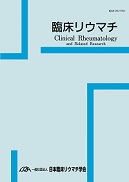Volume 19, Issue 2
Clinical Rheumatology and Related Research
Displaying 1-13 of 13 articles from this issue
- |<
- <
- 1
- >
- >|
editor's eye
-
2007Volume 19Issue 2 Pages 69-70
Published: June 30, 2007
Released on J-STAGE: December 30, 2016
Download PDF (200K)
journal article
-
2007Volume 19Issue 2 Pages 71-73
Published: June 30, 2007
Released on J-STAGE: December 30, 2016
Download PDF (200K)
review article
-
2007Volume 19Issue 2 Pages 75-80
Published: June 30, 2007
Released on J-STAGE: December 30, 2016
Download PDF (252K) -
2007Volume 19Issue 2 Pages 81-82
Published: June 30, 2007
Released on J-STAGE: December 30, 2016
Download PDF (154K)
original article
-
2007Volume 19Issue 2 Pages 83-88
Published: June 30, 2007
Released on J-STAGE: December 30, 2016
Download PDF (199K) -
2007Volume 19Issue 2 Pages 89-93
Published: June 30, 2007
Released on J-STAGE: December 30, 2016
Download PDF (330K) -
2007Volume 19Issue 2 Pages 94-101
Published: June 30, 2007
Released on J-STAGE: December 30, 2016
Download PDF (513K) -
2007Volume 19Issue 2 Pages 102-106
Published: June 30, 2007
Released on J-STAGE: December 30, 2016
Download PDF (602K)
journal workshop
-
2007Volume 19Issue 2 Pages 107-115
Published: June 30, 2007
Released on J-STAGE: December 30, 2016
Download PDF (396K) -
2007Volume 19Issue 2 Pages 116-122
Published: June 30, 2007
Released on J-STAGE: December 30, 2016
Download PDF (3194K) -
2007Volume 19Issue 2 Pages 123-130
Published: June 30, 2007
Released on J-STAGE: December 30, 2016
Download PDF (633K) -
2007Volume 19Issue 2 Pages 131-135
Published: June 30, 2007
Released on J-STAGE: December 30, 2016
Download PDF (444K)
Basic Medicine for Rheumatologist
-
2007Volume 19Issue 2 Pages 136-138
Published: June 30, 2007
Released on J-STAGE: December 30, 2016
Download PDF (481K)
- |<
- <
- 1
- >
- >|
